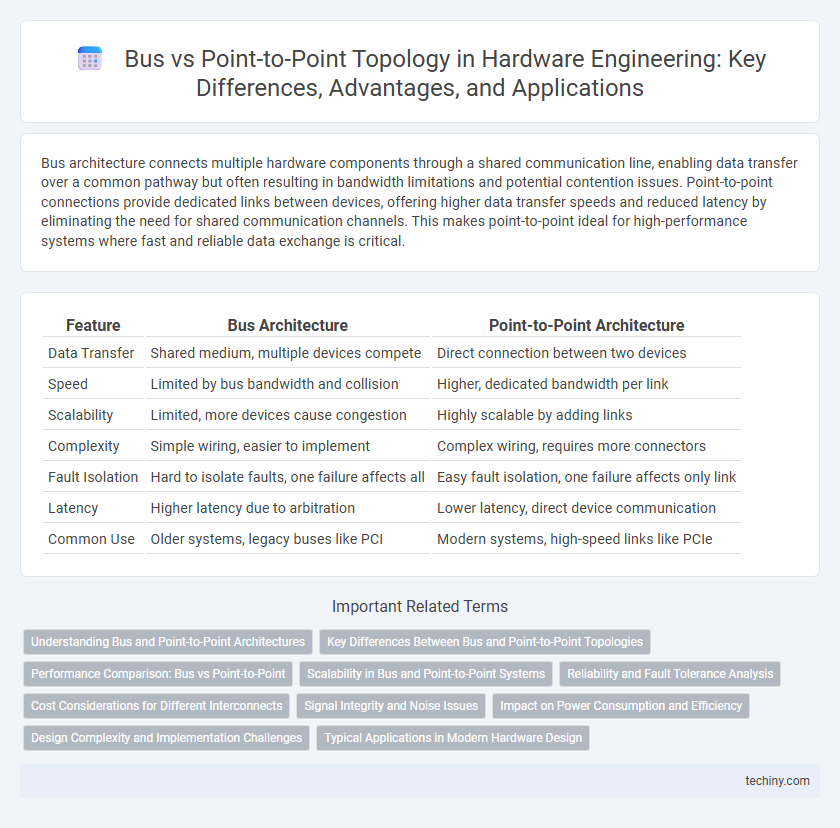Bus architecture connects multiple hardware components through a shared communication line, enabling data transfer over a common pathway but often resulting in bandwidth limitations and potential contention issues. Point-to-point connections provide dedicated links between devices, offering higher data transfer speeds and reduced latency by eliminating the need for shared communication channels. This makes point-to-point ideal for high-performance systems where fast and reliable data exchange is critical.
Table of Comparison
| Feature | Bus Architecture | Point-to-Point Architecture |
|---|---|---|
| Data Transfer | Shared medium, multiple devices compete | Direct connection between two devices |
| Speed | Limited by bus bandwidth and collision | Higher, dedicated bandwidth per link |
| Scalability | Limited, more devices cause congestion | Highly scalable by adding links |
| Complexity | Simple wiring, easier to implement | Complex wiring, requires more connectors |
| Fault Isolation | Hard to isolate faults, one failure affects all | Easy fault isolation, one failure affects only link |
| Latency | Higher latency due to arbitration | Lower latency, direct device communication |
| Common Use | Older systems, legacy buses like PCI | Modern systems, high-speed links like PCIe |
Understanding Bus and Point-to-Point Architectures
Bus architecture connects multiple devices using a shared communication pathway, enabling data transfer over a single set of wires but often resulting in bandwidth limitations and potential data collisions. Point-to-point architecture establishes direct links between devices, providing dedicated bandwidth and lower latency, which enhances overall system performance and scalability. Understanding the trade-offs between bus and point-to-point structures is crucial for optimizing hardware design, particularly in high-speed interconnects and complex integrated circuits.
Key Differences Between Bus and Point-to-Point Topologies
Bus topology features a single communication line shared by all devices, leading to potential data collisions and limited scalability, whereas point-to-point topology establishes a direct connection between each pair of devices, ensuring dedicated bandwidth and improved performance. Bus systems rely on terminators to prevent signal reflection, while point-to-point links do not require termination, enhancing signal integrity in complex hardware setups. Point-to-point configurations offer better fault isolation and higher data transfer rates, making them preferable in high-speed and high-reliability hardware engineering environments.
Performance Comparison: Bus vs Point-to-Point
Point-to-point interconnects offer higher performance than traditional bus architectures by enabling dedicated communication paths that reduce latency and increase bandwidth. Bus systems suffer from shared medium limitations, causing contention and bottlenecks as multiple devices compete for signal transmission. Modern hardware designs prioritize point-to-point links, such as PCIe and HyperTransport, to maximize throughput and minimize data transfer delays.
Scalability in Bus and Point-to-Point Systems
Bus systems face scalability challenges due to the shared communication medium, which leads to increased data collisions and bandwidth limitations as more devices connect. Point-to-point systems offer superior scalability by establishing dedicated links between devices, enabling higher data throughput and reduced latency with each added connection. This design facilitates seamless expansion in complex hardware architectures like modern multiprocessor systems and high-speed interconnects.
Reliability and Fault Tolerance Analysis
Bus architectures present single points of failure due to shared communication lines, reducing overall system reliability in hardware engineering. Point-to-point connections enhance fault tolerance by isolating faults to specific links, preventing cascading failures across the system. Analyzing reliability in these contexts involves assessing the impact of line failures and signal integrity, favoring point-to-point topologies for critical fault-tolerant hardware designs.
Cost Considerations for Different Interconnects
Cost considerations for bus versus point-to-point interconnects heavily influence hardware design decisions. Bus architectures typically reduce material and manufacturing expenses by sharing communication lines across multiple devices, lowering overall cost for simpler systems. Point-to-point connections increase component costs due to dedicated wiring and transceiver requirements but provide scalability and performance benefits essential for high-speed, complex hardware configurations.
Signal Integrity and Noise Issues
Bus architectures in hardware engineering often face signal integrity challenges due to multiple devices sharing a common communication line, leading to increased noise, reflection, and crosstalk. Point-to-point connections enhance signal integrity by providing dedicated signal paths, reducing interference and maintaining signal quality at higher frequencies. These direct links minimize degradation caused by impedance mismatches and electromagnetic interference, resulting in more reliable and faster data transmission.
Impact on Power Consumption and Efficiency
Point-to-point interconnects significantly reduce power consumption by minimizing signal interference and allowing lower voltage swings compared to shared bus architectures. Bus systems introduce higher capacitance and signal collisions, leading to increased power leakage and inefficient data transfer rates. Optimizing hardware with point-to-point connections enhances overall system efficiency by enabling targeted power management and reducing noise-induced retransmissions.
Design Complexity and Implementation Challenges
Bus architecture simplifies wiring by sharing a common communication line among multiple devices, reducing physical connections but increasing signal contention and timing complexity. Point-to-point design offers dedicated links between components, which enhances signal integrity and performance but requires more intricate routing and higher manufacturing costs. Engineers must balance the simplicity of bus systems against the increased complexity and scalability benefits of point-to-point topologies in hardware implementations.
Typical Applications in Modern Hardware Design
Bus architectures remain prevalent in legacy systems and embedded devices due to their cost-effectiveness and simplicity for connecting multiple peripherals. Point-to-point connections dominate high-performance computing and server environments, offering enhanced bandwidth and reduced latency between critical components like CPUs and GPUs. Modern hardware design increasingly favors point-to-point topologies in PCIe and high-speed serial interfaces for scalable and efficient data transfer.
bus vs point-to-point Infographic

 techiny.com
techiny.com